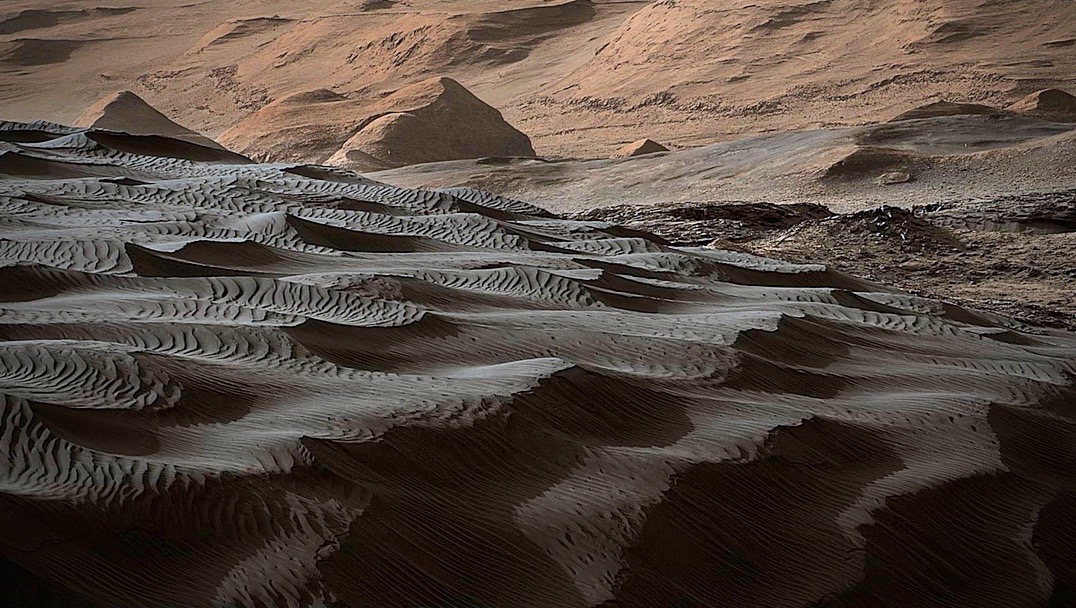Bagnold Dunes on:
[Wikipedia]
[Google]
[Amazon]
The Bagnold Dunes is a group of dark grey dunes in the
 In November 2015, NASA's rover ''
In November 2015, NASA's rover ''
Gale Crater
Gale is a crater, and probable dry lake, at in the northwestern part of the Aeolis quadrangle on Mars. It is in diameter and estimated to be about 3.5–3.8 billion years old. The crater was named after Walter Frederick Gale, an amateur ast ...
on Mars
Mars is the fourth planet from the Sun and the second-smallest planet in the Solar System, only being larger than Mercury. In the English language, Mars is named for the Roman god of war. Mars is a terrestrial planet with a thin at ...
. They are named after Ralph Alger Bagnold
Brigadier Ralph Alger Bagnold, OBE, FRS, (3 April 1896 – 28 May 1990) was an English 20th-century desert explorer, geologist and soldier.
In 1932, he staged the first recorded East-to-West crossing of the Libyan Desert. His work in the ...
, who crossed the Libyan Desert
The Libyan Desert (not to be confused with the Libyan Sahara) is a geographical region filling the north-eastern Sahara Desert, from eastern Libya to the Western Desert of Egypt and far northwestern Sudan. On medieval maps, its use predates t ...
and was one of the first explorers to acquire a deep understanding of the physics behind sand dunes. The dunes migrate around every Earth year.
Research
 In November 2015, NASA's rover ''
In November 2015, NASA's rover ''Curiosity
Curiosity (from Latin '' cūriōsitās'', from ''cūriōsus'' "careful, diligent, curious", akin to ''cura'' "care") is a quality related to inquisitive thinking such as exploration, investigation, and learning, evident by observation in humans ...
'' began exploring the dunes, finishing the exploration in April 2017. Phase 1 investigated Namib and High Dunes on the edge of the dune field during the late autumn and winter, while Phase 2 was conducted in the southern summer at the linear Nathan Bridges Dune and Mount Desert Island, a ripple field on the southern side of the dunes.
In a research paper published on November 1, 2021, the samples taken and examined by the rover in a wet-chemistry derivatization experiment were analyzed, and according to the research, the samples taken in the dunes contained organic compounds. Specifically, it found in the sand samples chemically derivatized ammonia
Ammonia is an inorganic compound of nitrogen and hydrogen with the formula . A stable binary hydride, and the simplest pnictogen hydride, ammonia is a colourless gas with a distinct pungent smell. Biologically, it is a common nitrogenous wa ...
and benzoic acid
Benzoic acid is a white (or colorless) solid organic compound with the formula , whose structure consists of a benzene ring () with a carboxyl () substituent. It is the simplest aromatic carboxylic acid. The name is derived from gum benzoin, ...
, as well as phosphoric acid
Phosphoric acid (orthophosphoric acid, monophosphoric acid or phosphoric(V) acid) is a colorless, odorless phosphorus-containing solid, and inorganic compound with the chemical formula . It is commonly encountered as an 85% aqueous solution, w ...
, phenol
Phenol (also called carbolic acid) is an aromatic organic compound with the molecular formula . It is a white crystalline solid that is volatile. The molecule consists of a phenyl group () bonded to a hydroxy group (). Mildly acidic, it ...
, several nitrogen
Nitrogen is the chemical element with the symbol N and atomic number 7. Nitrogen is a nonmetal and the lightest member of group 15 of the periodic table, often called the pnictogens. It is a common element in the universe, estimated at se ...
-bearing molecules, and as-yet unidentified high-molecular-weight compounds.
References
{{Mars-stub Dunes on Mars